May 3, 2022
Glasshouse Lighting: Is It Time To Turn Off Traditional Options?

Caption: Stock rendering of a glasshouse with traditional lighting options being used.
Editor’s Note: This post was written by Vertically Urban (VU), and is the second post of a two-part series. Read the first article on 5 Things Indoor Farmers Should Know When Choosing Their Grow Lights, and contact the Vertically Urban experts with questions here.
The Global Energy Crisis
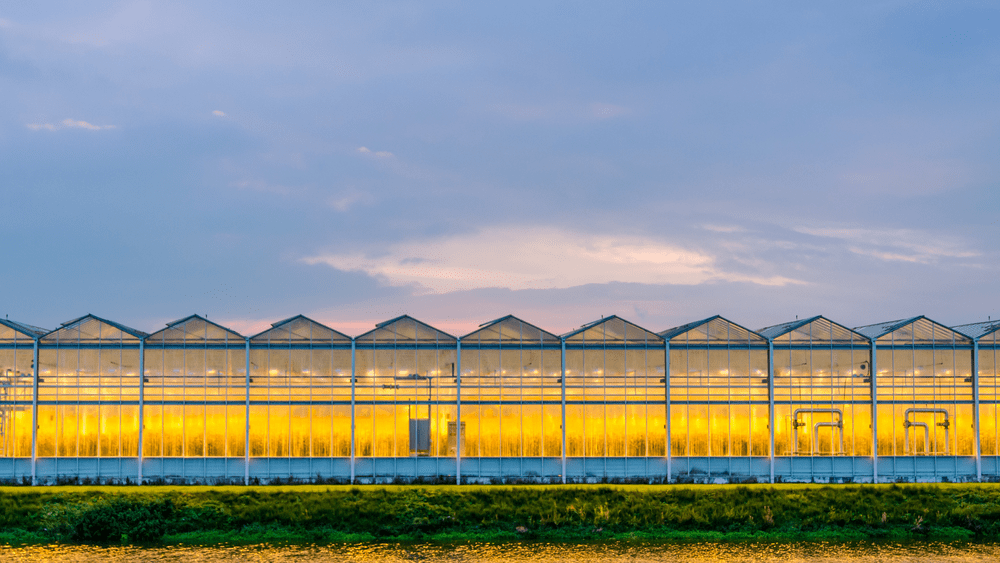
Will the pale orange glow of traditional high-pressure sodium (HPS) lighting become a thing of the past? Vertically Urban thinks so; stock image of a glasshouse.
The consequences of the recent increases in energy costs on the glasshouse industry are very sobering.
The trade body British Growers recently calculated that the production cost of a glasshouse grown cucumber looks set to hit 70 pence (equivalent to roughly $0.90 USD) later this year, where it previously cost around 25 pence to produce. Particularly scary when the current supermarket selling price is only 45 pence.
Of course, rising energy costs are not the only concern right now. However, prices of commodities such as fertilizers appear to be stabilizing and even beginning the slow drift back to more palatable levels. In contrast, the increase in energy costs looks set to be with us for the long haul.
To rapidly reduce energy consumption, some growers have resorted to the extreme measure of leaving their growing space unplanted during the colder months to save on heating costs, gambling on a long, productive summer to get them through.
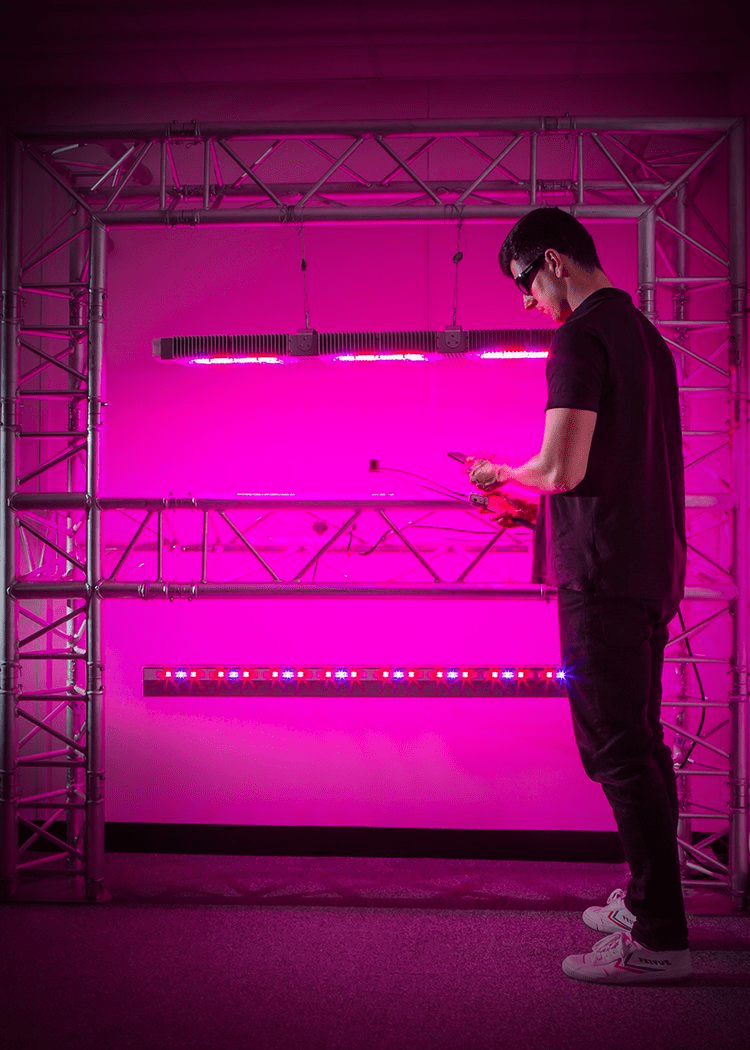
Prototype glasshouse luminaires undergo testing at Vertically Urban’s factory. Pictured here is Leon Gibson, Vertically Urban’s Design Engineer, conducting in-house trials. Image sourced from Vertically Urban.
The Big Switch
While the heating and cooling of glasshouses is by far the most energy-intensive activity, the lighting of the growing area is a close second.
For years incandescent lamps were the only option for growers, although more energy-efficient options are now commonplace.
The pale orange glow of high-pressure sodium (HPS) fixtures can be seen in the night sky around many modern glasshouses and whilst more efficient than their incandescent predecessors, they are only at their best in conjunction with natural daylight. In situations where natural sunlight is in short supply, the slightly less efficient ceramic metal halide option is preferable, being more suited to longer periods of illumination.
Both options have one huge drawback: their significant warm-up and cool-down times of 5-10 minutes.
This makes them unsuitable for solutions where lighting is used intelligently, on an intermittent basis. This does not just save energy; it can promote desirable growth characteristics too.
LEDs Are Both The Present And The Future
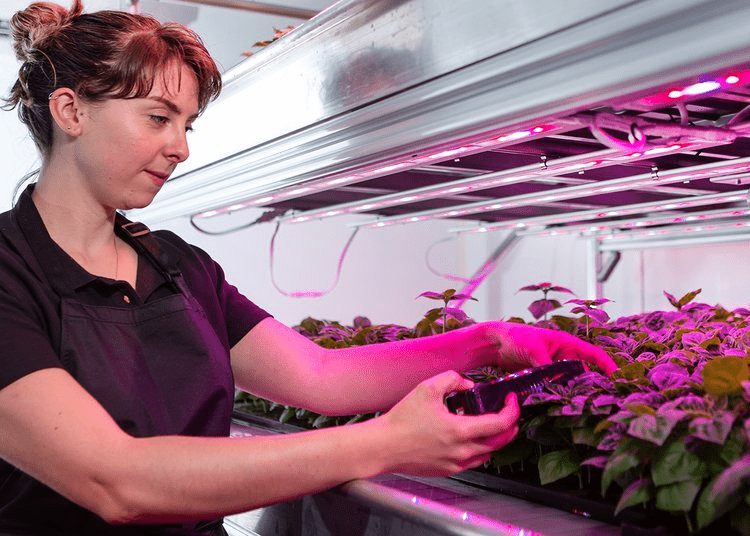
Vertically Urban has amassed huge amounts of knowledge and data from their trials and this has been the cornerstone for the development of its glasshouse spectra. Pictured here is Phoebe Sutton, Vertically Urban’s Plant Scientist, collecting data from one of Vertically Urban’s in-house trials. Image sourced from Vertically Urban.
When set against the backdrop of the energy crisis, one lighting technology stands out as the obvious option for savvy growers. LED-based luminaires can offer a massive 70% energy saving compared to HPS lighting and can last up to five times longer than metal halide options.
In addition, the absence of warm-up/cool-down requirements for LED lighting makes them ideal for intelligent systems where supplemental light levels are continuously adjusted depending on natural sunlight availability.
Phoebe Sutton, Vertically Urban’s plant biologist, adds that “the zero warm-up/cool-down time of LEDs allows precise tuning of the photoperiod, giving enhanced control over crop readiness, promoting or delaying fruiting as required.”
Vertically Urban: Experts In Horticultural LED Lighting
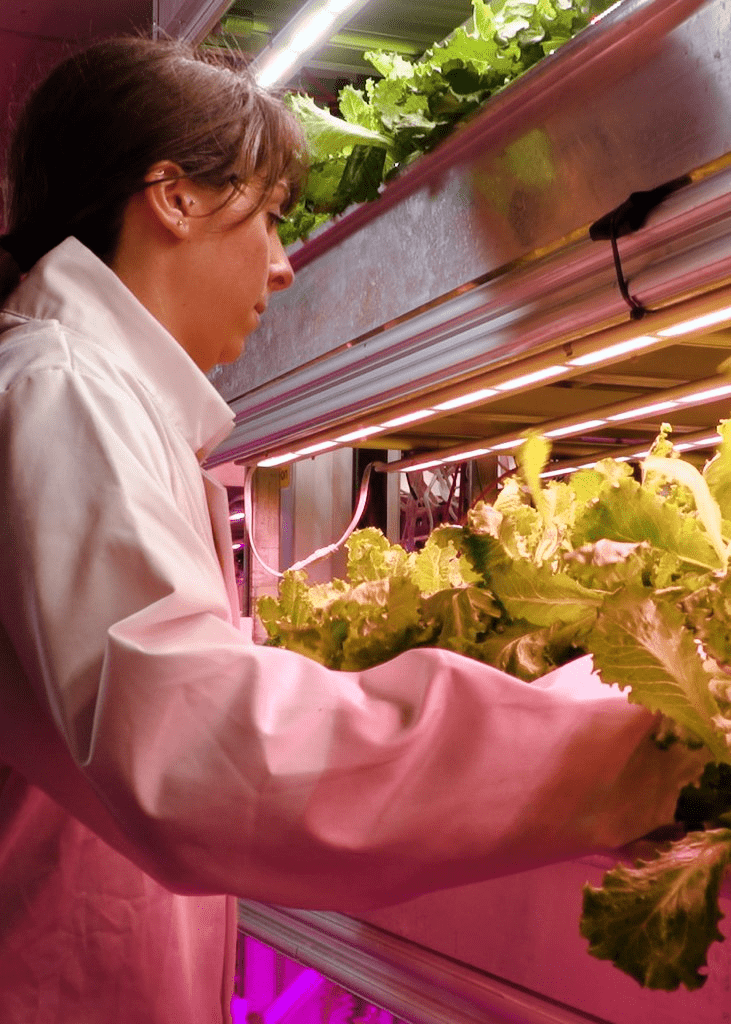
Vertically Urban’s Horti-bladeTM is an ultra-thin, high-efficiency luminaire designed for use in vertical farms. Pictured here is Phoebe Sutton, Vertically Urban’s Plant Scientist, removing a bed from one of VU’s trial beds for data collection. Image sourced from Vertically Urban.
UK-based Vertically Urban are LED horticultural lighting experts and have rapidly made a name for themselves as an innovative manufacturer in the sector. According to the firm, their Horti-bladeTM luminaire is not only one of the thinnest solutions available in the vertical farming market but also one of the most efficient.
CEO Andrew Littler adds “Vertically Urban already has a reputation for highly efficient luminaires, but we are keen to keep pushing the technological boundaries for what is possible.”
Housed at their factory in Leeds, VU's plant science team is constantly trialing novel solutions for various use cases. Most recently, they have set their sights on creating a suite of highly effective solutions for the glasshouse market.
Andrew further explains, “We have acquired huge amounts of knowledge and data from our trials and that has very much been the guiding light for the development of our glasshouse spectra with iterative improvements focused on boosting quality and flavor. We are confident you’ll see and taste the difference.”
Introducing The Odyssey Range
To share their LED lighting expertise in the glasshouse arena, Vertically Urban have developed their Odyssey range: 3 complimentary luminaires that seamlessly combine to create solutions for most applications.
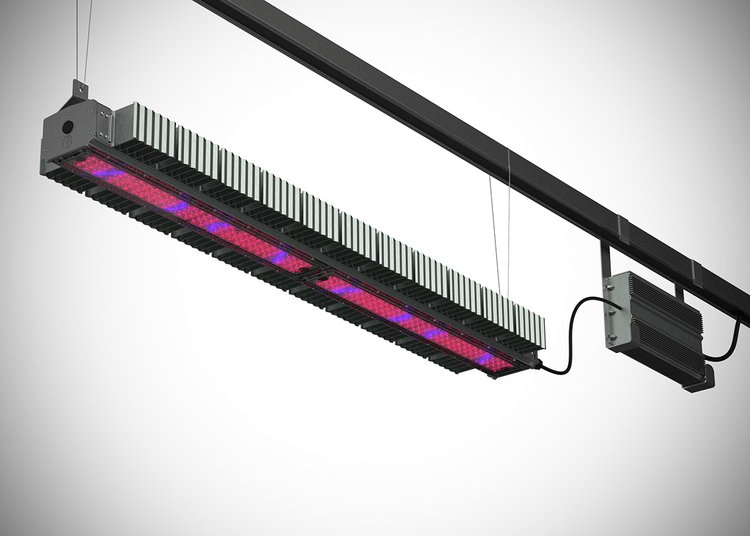
Vertically Urban’s Odyssey 600 is a high-power luminaire suitable for mid to high bay installations. Image sourced from Vertically Urban.
With over 15 years of experience in the lighting industry, VU’s Business Development Director, Jon Potter shares, “Our Odyssey range of glasshouse luminaires was born from the collision of solid horticultural science and 20 years of cutting-edge LED lighting knowledge. As a result, we have created solutions for the future, but with the journey starting today.”
The Odyssey 600 is the most powerful luminaire of the offering and is tailored to suit high bay installations, perfect for tomatoes, cucumbers, soft fruits, and medicinal crops. VU’s Odyssey 200 is a high efficiency, lower power option more suited to mid-height installation, especially useful for the propagation of seedlings. Capping off the current range is the Odyssey 100, a versatile inter-light for use between high-wire crops where overhead lighting struggles to penetrate.
Each of the Odyssey luminaires features the latest LED technology, a remote power supply, and IP66 rated for utmost protection. Additionally, they can be supplied with rear mounting brackets or a wire suspension kit for ease of installation within current setups.
Can You Afford To Not Upgrade?
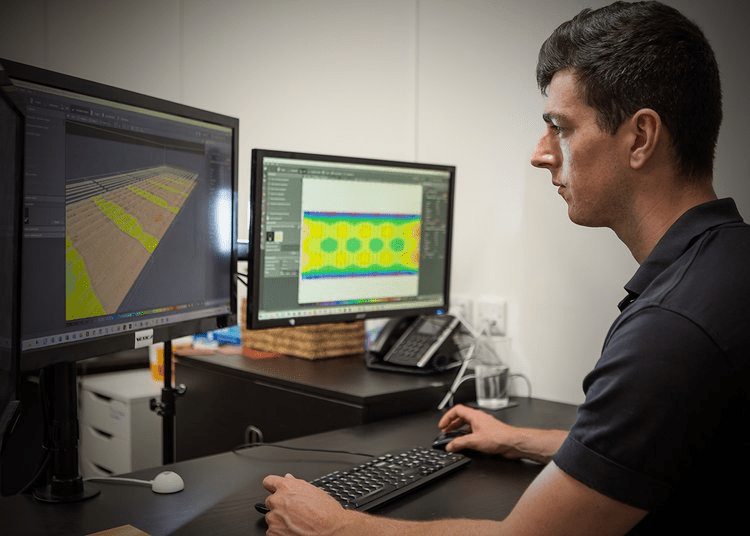
Simulations run by VU’s in-house project designers can assist in putting together a solid business case, affording the best chance of a successful funding application. Pictured here is Leon Gibson, Vertically Urban’s Design Engineer, conducting a simulation for a potential project. Image sourced from Vertically Urban.
Of course, opting for a premium LED lighting product will likely lead to higher initial capital expenditure (CAPEX), but the resulting reduction in operating expense (OPEX) will often be extremely significant. In turn, this can allow for a much shorter payback period and increased ROI which should make funding easier to secure as more and more grants have an environmental impact assessment built into their awarding criteria.
Vertically Urban has built up a wealth of successful funding experience. Their team of in-house project designers can assist you in putting together a solid business case giving you the best chance of a successful funding application. Andrew Littler suggests approaching Vertically Urban early in the project development timeline. “This allows us the best opportunity to help connect the dots between us, you and funding houses.”
The energy crisis looks set to be a part of our reality for a considerable time to come with no indications that price hikes are even close to being finished. Coupled with wider environmental concerns, this means that it is near impossible to ignore the call to move towards a less energy-hungry and more sustainable future. Investing in LED lighting for your glasshouse eases the strain on current operating finances and helps you transition towards a farm for the future.


